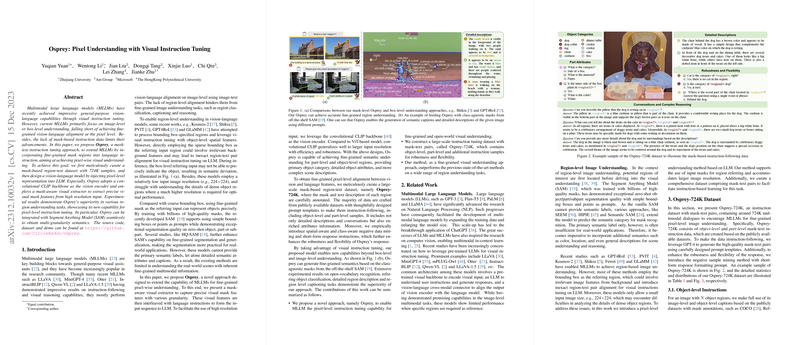Analyzing Osprey: Pixel Understanding with Visual Instruction Tuning
Osprey presents a significant advancement in the field of multimodal LLMs (MLLMs), focusing on pixel-level vision-language alignment. Traditional MLLMs have excelled in image-level understanding but often lacked fine-grained alignment, limiting their efficacy in tasks requiring detailed region-based comprehension. Osprey addresses this gap through mask-text instruction tuning, which integrates fine-grained mask regions into language instruction for achieving pixel-wise visual understanding.
Methodological Innovations
Osprey introduces a novel Mask-Aware Visual Extractor that integrates precise visual mask features with LLMs. This process involves leveraging a convolutional CLIP backbone as the vision encoder, known for its efficient handling of high-resolution images compared to ViT-based models. The approach enhances model coverage by meticulously curating a substantial dataset, Osprey-724K, consisting of mask-based region-text pairs. This dataset is pivotal to extending MLLMs towards pixel-level instructions.
The model operates by injecting pixel-level representations from the masks into a LLM after processing multi-level features through mask pooling and linear transformations. This integration allows Osprey to provide detailed semantic interpretations, object attributions, and complex scene descriptions at both the part and object level.
Experimental Validation
The efficacy of Osprey is demonstrated through extensive experimental tasks, including:
- Open-Vocabulary Segmentation: Osprey shows a substantial performance increase over existing models like GPT4RoI and Ferret, reflecting its capability in achieving superior pixel-level segmentation and recognition.
- Referring Object Classification: The model significantly outperforms existing methods on both LVIS and PACO datasets, showcasing its proficiency in identifying and describing nuanced details of object parts and categories.
- Description and Reasoning Tasks: When evaluated on the Ferret-Bench and detailed region description tasks, Osprey achieves high accuracy and surpasses state-of-the-art models in providing insightful and articulate responses.
The paper also explores the implication of negative samples and short-form prompts in mitigating object hallucination, as evaluated by the POPE benchmark. Osprey's approach to integrating diverse prompts and a robust dataset is validated by its competitive performance across diverse settings.
Implications and Future Directions
The advancements presented by Osprey have significant implications for AI applications requiring detailed image comprehension, such as autonomous systems, detailed scene analysis, and improved human-computer interaction interfaces. The pixel-level alignments forged by Osprey could lead to more interactive and context-aware AI systems that adeptly handle complex visual data.
Future developments could explore the expansion of Osprey's capabilities to more complex datasets and broader application areas. Further improvements in model efficiency, perhaps by integrating more streamlined processing architectures, could also enhance the adaptability and scalability of this approach. Additionally, the exploration of real-time applications and integration with interactive media formats presents a promising avenue for leveraging Osprey’s advanced visual understanding capabilities.
Overall, Osprey contributes significantly to the field of multimodal AI by refining the granularity at which models can understand and interact with visual data, laying a foundation for more detailed and context-rich AI systems in the future.
